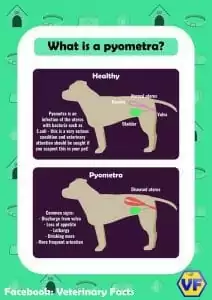This infographic is from Veterinary facts, a page created to share interesting and useful information about pets and how to look after them.
WHAT IS PYOMETRA IN DOGS AND CATS?
Pyometra is defined as a uterine infection. It is always seen in unaltered females regardless of their breeding status.
Pyometra is an important disease to be aware of for any dog or cat owner because of the sudden nature of the disease and the deadly consequences if left untreated. It has been compared to acute appendicitis in humans because both are essentially empyemas within an abdominal organ.
WHAT ARE THE SYMPTOMS OF PYOMETRA IN DOGS AND CATS?
The clinical signs of pyometra will vary depending on if the cervix is closed or not. Symptoms in a closed pyometra are usually more severe, as the bacteria and pus in the uterus are not able to drain. This will causes severe illness and pain. Some symptoms include:
- Anorexia
- Lethargy
- Fever
- Abdominal pain
- Increased thirst
- Vomiting
Symptoms in an open pyometra can include:
- Pus discharge from the vulva
- Discharge found on the tail or back end
- Lethargy
- Anorexia
- Fever
- Abdominal pain
- Increased thirst
- Vomiting
WHAT CAUSES PYOMETRA IN DOGS AND CATS?
Pyometra is a result of hormonal and structural changes in the uterus lining. This can happen at any age, whether she has bred or not, and whether it is her 1st or 10th heat. The main risk period for a female is for eight weeks after her peak standing heat (or estrous cycle) has ended. Normally during this period, the cervix, which was open during her heat, begins to close, and the inner lining begins to adapt back to normal. However, cystic hyperplasia of the endometrium (inner lining of the uterus) – known as cystic endometrial hyperplasia (CEH) – may occur at this time for some animals, as an inappropriate response to progesterone.
Under these circumstances, bacteria that have migrated from the vagina into the uterus find the environment favorable to growth, especially since progesterone also causes mucus secretion, closes the cervix (preventing uterine drainage), and decreases uterine contractility.
TREATMENT OF PYOMETRA
Surgical removal of the uterus and ovaries (ovariohysterectomy-spay) is the recommended course of treatment for pyometra in dogs and cats. While some owners would like a less invasive treatment, surgery is absolutely the only way to eradicate the infection and prevent future complications. The possibility of successful treatment without surgery is extremely low. When a dog is diagnosed early, they are good surgical candidates, and often recover fully. Unfortunately, pyometra symptoms can be vague to pet owners, so often pets present in the very ill stages of this condition. In these cases, it is recommended to have the pet stabilized before and after surgery, and be hospitalized after to monitor for complications. Dogs and cats with pyometra are often sent home with a 2-week course of antibiotics following surgery.
PREVENTION OF PYOMETRA
The only certain prevention for pyometra is through routine spay. Pyometra is a deadly condition, so routine spay is always recommended in order to help each animal live a long and healthy life.

